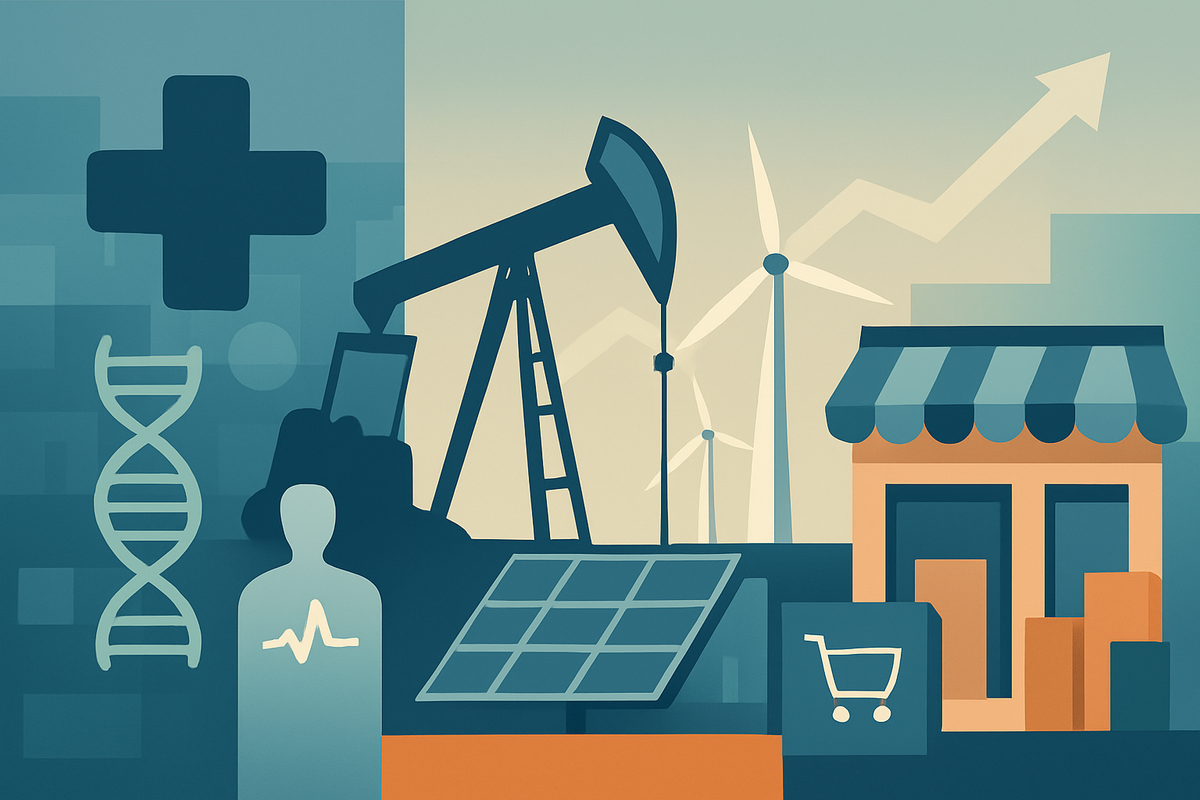
As the technology sector continues its AI-fueled ascent, often dominating headlines with its rapid innovations and soaring valuations, a closer look at other vital market segments reveals a tapestry of distinct performance trends. In November 2025, the healthcare, energy, and consumer goods sectors are navigating their own unique landscapes, shaped by macroeconomic shifts, evolving consumer behaviors, and strategic adaptations. While the tech juggernaut commands significant attention, these foundational industries demonstrate resilience, strategic pivots, and considerable underlying potential, offering investors a more diversified view of market health beyond the digital frontier.
These sectors, though less volatile than their tech counterparts, are far from stagnant. Healthcare grapples with cost pressures and workforce shortages while strategically integrating AI, aiming for efficiency and improved patient outcomes. The energy sector, a traditional defensive play, showcases resilience amidst geopolitical turbulence and a complex transition towards a diversified energy mix. Meanwhile, consumer goods companies are keenly focused on intentional spending patterns, product innovation, and leveraging digital tools to capture value-conscious consumers. Each sector's trajectory reflects a unique interplay of challenges and opportunities, painting a nuanced picture of the broader economic environment.
Sectoral Deep Dive: Navigating Unique Headwinds and Tailwinds
Healthcare: Strategic AI Adoption Amidst Enduring Challenges
The healthcare sector, despite its fundamental importance driven by an aging global population and rising chronic disease burden, has presented a mixed bag for investors. As of November 2025, the sector has experienced what some analysts describe as "lackluster results" over the past three years, with a retreat of 4.1% by May 2025. This muted performance comes despite the "immense growth potential" inherent in its demographic drivers. The sector is currently under "unprecedented stresses," including unsustainable costs, significant manpower shortages—projected to reach 54,100 to 139,000 physicians by 2033—and financial strains on Medicare Advantage plans.
Despite these headwinds, the industry is not static. Health systems are increasingly turning to municipal bonds to fund critical strategic growth investments, particularly in robust digital infrastructure such as enterprise resource planning (ERP) platforms and electronic health records (EHR). Artificial intelligence (AI) is emerging as a transformative force, albeit with a "more measured pace relative to other sectors" due to stringent regulatory oversight. Investment is notably shifting towards AI-driven solutions in provider operations, outpacing other areas of health tech. This adoption aims for significant efficiency gains, enhanced diagnostic accuracy, and personalized treatment plans. Mergers and acquisitions (M&A) are also anticipated to rise in 2025, driven by financially distressed hospitals seeking stability and stronger organizations looking to expand resources and capabilities. Regulatory scrutiny of AI in healthcare is intensifying, demanding clear governance and adherence to data quality standards to ensure ethical deployment.
Energy: Resilience Amidst Volatility and Transition
The energy sector has carved out a distinct path, often acting as a resilient "defensive play" during periods of broader market volatility. In Q1 2025, it was a "standout performer," delivering a 9.9% total return, notably outperforming growth-oriented sectors like technology when they faced headwinds. Geopolitical tensions and fluctuations in global energy demand have been significant contributors to positive sentiment within the energy market. Brent crude prices, reflecting these tensions, settled around $68.89 per barrel in early November 2025.
The North American energy landscape is undergoing a profound transformation. Surging electricity demand, fueled by the proliferation of data centers, widespread electrification, and the growing adoption of electric vehicles, is reshaping the industry. This demand surge is driving continued growth in clean energy sources, while natural gas is firmly positioned as a crucial transitional fuel, complementing the ongoing demand for oil and gas, particularly as a lower-carbon alternative to coal for power generation. AI is also making inroads, enhancing innovation, operational efficiency, and risk reduction, and crucially, supporting renewable energy strategies. However, the sector faces "unprecedented uncertainty" and "substantial volatility" from conflicting narratives of supply oversupply versus geopolitical risks and unpredictable policy shifts. Furthermore, progress in critical areas of the energy transition, such as carbon capture, hydrogen fuels, and heavy industry decarbonization, has reportedly stalled in the US and EU during 2025.
Consumer Goods: Intentional Spending and Digital Influence Drive Evolution
The consumer goods sector in November 2025 is characterized by a "slow and steady consumer recovery" and a pronounced shift towards "intentional spending." The lingering impact of the cost-of-living crisis means consumers are more discerning, actively seeking discounts, and driving a rise in private-label sales. Despite these pressures, global sales for the Consumer Tech & Durables segment are forecast to achieve 2% growth in 2025, reaching $1.29 trillion USD.
Product innovation remains a top priority, with 95% of consumer products executives planning increased investment in this area for 2025. Companies are rethinking demand generation strategies, boosting marketing and advertising expenditures, and offering more sales discounts and promotions to attract value-seeking consumers. Digitalization and AI are profoundly influencing shopping experiences; nearly one in four consumers now use generative AI for shopping, and 68% are willing to act on its recommendations, particularly among younger demographics. Sustainability continues to be a critical factor, influencing 64% of consumers, with some willing to pay a premium for eco-friendly options. Consumers prioritize affordability and clear, tangible value from products, including AI-enabled devices. Emerging markets and North America are key growth drivers, with resilient trade flows in regions like India, the Middle East, and Africa bolstering export potential. However, geopolitical volatility and economic uncertainty, including potential tariffs, could still dampen consumer spending, and many companies continue to face strong pricing headwinds into 2025 after struggling with volume growth in 2024.
Companies on the Horizon: Potential Winners and Losers
The distinct dynamics within each sector are creating clear winners and losers, reshaping competitive landscapes.
In healthcare, companies at the forefront of AI integration and efficiency solutions are poised for growth. Providers successfully adopting AI for operational enhancements and personalized medicine, such as those investing heavily in robust digital infrastructure, are likely to gain market share. For instance, UnitedHealth Group (NYSE: UNH), with its vast Optum division focusing on technology and data analytics for healthcare services, stands to benefit from the drive for efficiency and AI adoption. Similarly, specialized medical device companies leveraging AI for diagnostics or surgical assistance, like Intuitive Surgical (NASDAQ: ISRG), could see increased demand. Conversely, smaller, financially distressed hospitals unable to invest in new technologies or attract skilled labor will likely face continued pressure, potentially leading to further consolidation or closures. Traditional pharmaceutical companies that fail to adapt to AI-driven drug discovery or personalized medicine trends might also lag.
The energy sector presents opportunities for both traditional and new energy players. Companies heavily invested in natural gas infrastructure and production, such as Cheniere Energy (NYSE: LNG) or EQT Corporation (NYSE: EQT), are well-positioned given the surging electricity demand and natural gas's role as a transitional fuel. Furthermore, utilities and renewable energy developers focused on expanding grid capacity and integrating clean energy sources, like NextEra Energy (NYSE: NEE), could thrive amidst the energy transition. On the other hand, oil and gas companies heavily reliant on older, less efficient extraction methods or those slow to embrace AI for operational optimization may struggle with cost competitiveness and environmental pressures. Companies with significant exposure to stalled carbon capture or hydrogen projects in the US and EU might also face setbacks.
In consumer goods, companies that excel in product innovation, digital engagement, and value offerings are set to outperform. Brands that effectively leverage generative AI for customer engagement and personalized shopping experiences, while also focusing on sustainable and affordable products, will likely capture consumer loyalty. Large consumer staples companies like Procter & Gamble (NYSE: PG) or Unilever (NYSE: UL) that can adapt their portfolios to meet demand for both value and sustainability, alongside strong digital marketing, are well-positioned. E-commerce platforms and direct-to-consumer brands that offer seamless, AI-enhanced shopping experiences could also see continued growth. Conversely, traditional retailers or consumer brands that fail to innovate, offer competitive pricing, or adapt to digital and AI-driven consumer behaviors may lose market share to more agile competitors and private-label alternatives. Companies heavily exposed to regions with significant geopolitical instability or trade tariff risks could also face supply chain disruptions and reduced demand.
Wider Significance: A Shifting Economic Landscape
The distinct performance of healthcare, energy, and consumer goods sectors in November 2025 reflects a broader recalibration of the global economy, moving beyond the singular focus on tech-driven growth. This period highlights the increasing importance of fundamental economic drivers and the strategic integration of technology, rather than its sole dominance.
In healthcare, the trend of strategic AI adoption underscores a critical shift towards efficiency and data-driven decision-making to combat escalating costs and workforce shortages. This isn't just about technological advancement; it's a structural necessity for the industry's long-term viability. Regulatory bodies are playing an increasingly crucial role, with intensified scrutiny on AI in healthcare setting precedents for responsible innovation across other sensitive sectors. Historically, healthcare has been seen as a defensive sector due to inelastic demand, but its current challenges, coupled with technological integration, suggest a more complex future. The M&A activity points to a consolidation phase, mirroring past cycles where smaller, struggling entities were absorbed by larger, more resilient players seeking scale and diversified capabilities.
The energy sector's resilience and volatility signify its enduring strategic importance amid global geopolitical flux and the accelerating, yet often uneven, energy transition. The surge in electricity demand from data centers and EVs is a powerful new variable, creating a significant ripple effect across the energy supply chain and infrastructure development. This trend reinforces the critical role of natural gas as a bridge fuel, challenging narratives that exclusively prioritize immediate, full-scale renewable adoption. The stalled progress in certain green technologies in the US and EU indicates regulatory and economic hurdles that could temper the pace of the transition, potentially prolonging the relevance of traditional energy sources. This mirrors historical energy crises where geopolitical events dramatically influenced commodity prices and energy policy, emphasizing the sector's sensitivity to global events.
For consumer goods, the emphasis on "intentional spending" and value reflects a post-inflationary consumer mindset, where purchasing decisions are more deliberate. This trend forces companies to innovate not just in product features but also in pricing and perceived value, pushing a shift from brand loyalty to value-driven choices. The widespread adoption of generative AI in shopping experiences is a game-changer, fundamentally altering how consumers discover and purchase products. This digital transformation has parallels to the rise of e-commerce, which similarly disrupted traditional retail models. Regulatory scrutiny over data privacy and AI ethics in consumer applications is likely to intensify, influencing how companies leverage these powerful tools. The resilience of trade flows in emerging markets suggests a rebalancing of global economic power, making these regions increasingly critical for multinational consumer brands.
What Comes Next: Navigating a Complex Future
The coming months and years will likely see these sectors continue their distinct evolutions, presenting both significant opportunities and formidable challenges.
In healthcare, the short-term focus will remain on managing operational costs and mitigating workforce shortages, with AI deployments becoming increasingly critical for efficiency gains. Long-term, we can expect a sustained push towards personalized medicine, preventative care, and integrated health systems, heavily reliant on advanced data analytics and AI. Strategic pivots will include greater investment in digital health infrastructure and a renewed emphasis on talent acquisition and retention strategies. Market opportunities will emerge for companies providing AI-powered diagnostic tools, telemedicine platforms, and solutions for healthcare workforce management. Challenges will include navigating complex regulatory frameworks for AI, ensuring data security and privacy, and managing the ethical implications of advanced health technologies. Potential scenarios range from a gradual, AI-assisted transformation of healthcare delivery to a more rapid, disruptive shift driven by tech companies entering the health space.
The energy sector faces a dynamic short-term outlook, heavily influenced by geopolitical developments and commodity price volatility. The ongoing surge in electricity demand from data centers and EVs will continue to be a dominant factor, driving investment in both traditional grid infrastructure and renewable energy expansion. Long-term, the sector will accelerate its transition towards a diversified energy mix, with natural gas playing a critical bridging role alongside renewables. Strategic pivots will involve increased investment in grid modernization, energy storage solutions, and potentially renewed efforts in areas like carbon capture if policy support materializes. Market opportunities lie in renewable energy development, smart grid technologies, and sustainable energy infrastructure. Challenges include managing the intermittency of renewables, securing critical minerals for battery storage, and navigating evolving climate policies. Potential outcomes range from a stable, managed energy transition to periods of acute energy supply/demand imbalances driven by unforeseen global events.
For consumer goods, the short-term will see companies double down on demand generation strategies, focusing on value propositions and targeted promotions to appeal to cautious consumers. Product innovation, particularly in sustainable and AI-enabled devices, will remain paramount. Long-term, the sector will be shaped by hyper-personalization driven by AI, increasing direct-to-consumer models, and a heightened focus on circular economy principles. Strategic adaptations will involve agile supply chain management, continuous investment in digital marketing, and a deeper understanding of regional consumer preferences. Market opportunities exist for brands that can effectively integrate AI into the customer journey, offer compelling value, and build strong sustainable credentials. Challenges include managing supply chain disruptions, adapting to fast-changing consumer trends, and navigating potential regulatory oversight on AI usage and data privacy. Scenarios range from a steady recovery driven by innovation and digital engagement to potential setbacks from economic downturns or geopolitical trade conflicts.
Comprehensive Wrap-Up: Navigating a Multi-faceted Market
The financial markets in November 2025 are far more nuanced than a simple narrative of tech dominance suggests. While the technology sector continues its robust, AI-fueled growth, the healthcare, energy, and consumer goods sectors are each carving out distinct, complex, and significant trajectories. The key takeaway is that these foundational industries are not merely reacting to market forces but are actively evolving through strategic investments in technology, adaptation to consumer behavior shifts, and navigation of intricate regulatory and geopolitical landscapes.
Moving forward, investors should recognize the diversified nature of market opportunities. Healthcare, despite its current struggles, holds immense long-term potential driven by demographic shifts and the transformative power of AI for efficiency and outcomes. The energy sector offers resilience and defensive characteristics, with opportunities in both traditional and transitional energy sources driven by surging electricity demand. Consumer goods are adapting to a more discerning consumer, emphasizing value, innovation, and digital engagement.
What investors should watch for in the coming months includes the pace of AI integration across all sectors and its tangible impact on profitability and efficiency. Regulatory developments, particularly concerning AI ethics and data privacy in healthcare and consumer goods, will be critical. Geopolitical stability will continue to heavily influence the energy sector, while consumer spending patterns and inflation data will dictate the trajectory of consumer goods. A balanced portfolio that considers the unique risks and rewards across these diverse sectors, rather than solely focusing on high-growth tech, will be crucial for navigating the multi-faceted market landscape ahead.
This content is intended for informational purposes only and is not financial advice





